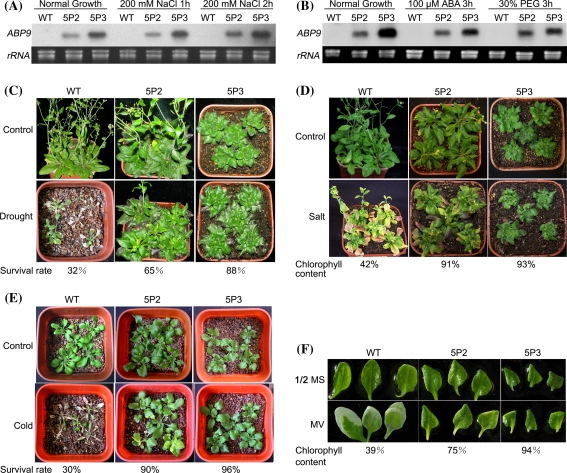Fig. 3.
Constitutive expression of ABP9 enhances tolerance to drought, salt, cold and oxidative stresses in transgenic Arabidopsis. a, b RNA gel blot analysis of ABP9 expression in wild type (WT) and 35S-ABP9 transgenic plants (5P2 and 5P3) under normal growth and salt stress (a), ABA and PEG treatment conditions (b). Plants grown on 1/2 MS agar plates were untreated or treated with 200 mM NaCl for 1 h and 2 h, 100 μM ABA or 30% PEG for 3 h. Equal amounts (8 μg) of total RNAs separated by electrophoresis on formaldehyde-agarose gels and rRNA was used as loading control. c Drought tolerance in 35S-ABP9 transgenic plants. Intact plants were drought stressed by withholding water for 4 weeks, then were rewatered for 1 week before photograph was taken. Survival rates were calculated from the results of three independent experiments (n ≥ 30 for each experiment). Untreated plants grown under normal conditions as control were shown in the top panels. d Capacity of 35S-ABP9 transgenic plants to tolerate salt stress. The plants were treated with progressively increased concentrations of NaCl solutions ranging from 50 to 200 mM and kept irrigated with 200 mM NaCl for 12 days, then chlorophyll contents were determined. Percentage shown are chlorophyll content of salt-stresses plants relative to that of untreated ones from the results of three independent experiments with 5 intact seedlings determined for each experiment. Untreated plants grown under normal conditions as control were shown in the top panels. e Freeze tolerance of 35S-ABP9 transgenic plants. Plants were exposed to freezing temperature −4°C for 6 h and recovered for 1 week under normal growth conditions. Survival rates were counted from the results of three independent experiments (n ≥ 30 for each experiment). Untreated plants grown under normal conditions as control were shown in the top panels. f Tolerance to oxidative stress in 35S-ABP9 transgenic plants. Rosette leaves from wild-type (WT) plants and transgenic lines (5P2 and 5P3) were floated in 1/2 MS medium containing 2 μM MV for 72 h before photographs were taken. Chlorophyll contents compared to that of mocked-treated samples are shown at the bottom. Shown are representative photographs from 30 seedlings in triplicates

